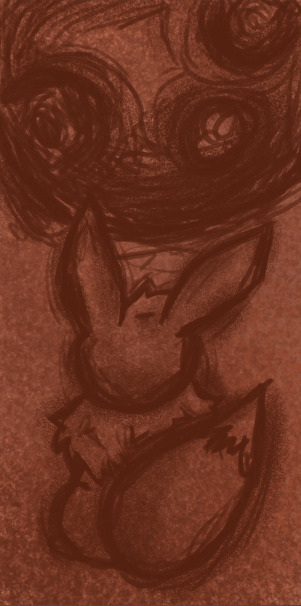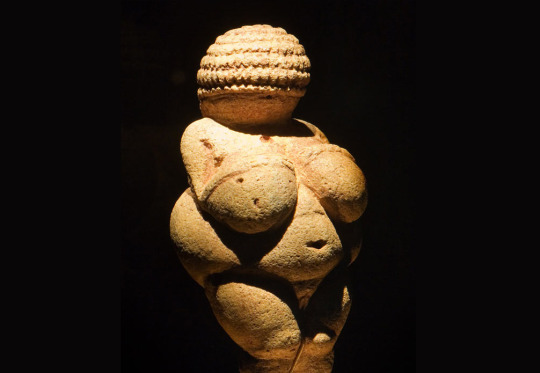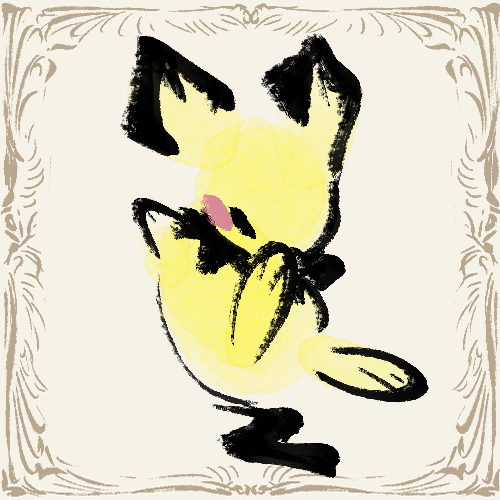#CaveArt
Explore tagged Tumblr posts
Text

Before Us
sketch of ych
35 notes
·
View notes
Text

We comin' for those robots
6 notes
·
View notes
Text

#eevee#moon#cave#caveart#digital art#digital artwork#artist#pokemon#pkmn#digital artist#digital illustration#digital drawing
7 notes
·
View notes
Text
The Venus of Willendorf

Exploring the Majestic Venus of Willendorf: A Paleolithic Masterpiece
The Venus of Willendorf, considered the most illustrious among the Paleolithic Venuses, is a statuette carved from oolitic limestone and adorned with red ochre paintings, standing at a height of 11 cm. Dated between 24,000 and 22,000 B.C., this iconic work of art is not native to the region where it was discovered but now reigns supreme in the Naturhistorisches Museum in Vienna.
Chronicle of an Extraordinary Discovery
In 1908, archaeologist Josef Szombathy discovered the Venus of Willendorf at an archaeological site near Willendorf in der Wachau, along the left bank of the Danube in Austria. The Paleolithic site underwent careful examination around 1990, allowing a reevaluation of previous estimates regarding the artwork's dating. Stratigraphic analysis indicated that the statuette was created between 25,000 and 26,000 years ago, a significant correction from earlier estimates that erroneously placed it between 10,000 B.C. and 32,000 B.C.
Sculptural Anatomy: Details and Vibrant Colors
The Venus of Willendorf, representing a nude female figure, rests her arms on her breasts. The most distinctive features are the rounded and ample forms, while facial features are deliberately left uncarved. The spherical head is covered with a hairstyle interpreted as a headdress of shells or a coiffure, perhaps reminiscent of the curly and frizzy hair typical of the African population.
The reddish clay surface, combined with the yellowish and porous limestone, creates a play of light and shadow that highlights the roughness of the surface. The underlying shadow emphasizes the abundant shapes of the figure, creating a suggestive chiaroscuro effect.
Symbolic Meaning: Fertility and Mother Earth Worship
The Venus of Willendorf, the precursor of prehistoric Venuses, is steeped in symbolism. These statuettes, usually ranging from 3 to 15 cm, often feature elongated legs and heads, perhaps suggesting the practice of embedding them in fields or among cave rocks, according to the customs of the time.
Accentuated sexual traits, such as monumental breasts, a prominent belly, and ample buttocks, are interpreted as symbols of fertility. The Venus of Willendorf, with its pronounced forms and attention to detail in sculpture, connects to the worship of Mother Earth and her ability to foster prosperity.
In conclusion, this statuette embodies the symbolism of an era where population growth was pivotal in elevating social status, emphasizing the primary importance of births in the construction of a civilization.
#VenusofWillendorf#PaleolithicArt#AncientSculpture#PrehistoricSymbolism#ArchaeologicalDiscovery#HistoricalMasterpiece#MotherEarthWorship#CulturalHeritage#AncientGoddess#SymbolsofFertility#ArtisticExpression#ViennaMuseum#AncientCivilization#HistoricalArtifacts#PrehistoricWisdom#ChiaroscuroEffect#CaveArt#CulturalLegacy#AncientSymbols#ArchaeologicalWonder
2 notes
·
View notes
Text


The Voids
.
.
.
Similarly to the Aeon Caves there are enormous cavities in and around the Void Caves. These cavities are called voids and can range in size from a few miles to hundreds of miles across. Like Aeons, they can host an atmosphere of their own where it’s nearly impossible to look up and see the ceiling. They are reflective of the day/night time cycles seen on the surface as spiritual activity brightens the “sky” during the day and darkens deeply at night. The largest void, the Umbra Void, is home to the dark Goddess Obsidian and her God Crystal.
#originalstory#worldbuilding#worldbuildingart#oc#biome#fantasyillustration#illustration#digitalillustration#storytelling#conceptart#caveart#cave#brownart#brownillustration#originalart
0 notes
Text

Our environment can be the canvas for art & design!
1 note
·
View note
Text

"Adaptation is necessary" Another view of my previous piece, where Kana shows Hibito that a group of Flabebe and Floette have started using the glowing Fairy Flowers.
This is a companion piece to my previous piece! https://www.tumblr.com/thekamelotbard/759903961748832256/life-is-everywhere-you-just-have-to-look-for
Support The Artist!
Patreon! patreon.com/OpenSkiesTKB?utm_m…
Kofi! ko-fi.com/thekamelotbard0732
For Comic Merch; www.teepublic.com/user/thekamelotbard | www.redbubble.com/people/theka…
#caveart#greenfur#originalcharacters#malecharacter#femalecharacter#flabebe#floette#pokemon#crossover
0 notes
Text

Oldest Neanderthal Engravings Have Been Preserved in a Cave for 57,000 Years. By Madeleine Muzdakis. Hakai Magazine
Picture; Scientists examining the cave’s interior. (Photographer: Kristina Thomsen) #neanderthal #caveart
27 notes
·
View notes
Text
Which shirt would you rock on your next tropical vacation? 🩵 or 🧡? Comment your answer!🥳🌸🌴☀️🌊 (Model is wearing a size extra small!) Both shirts are available on link in bio!💖 Get yours today before they sell out!👀🩵🧡 #fyp #seabunny #caveart #buttondownshirt #shirt #vacation #trending
3 notes
·
View notes
Text
Oh, I thought you were trying to recreate the shape language seen in paleolithic caveart



Poorly drawn Pichu line [redo]
15K notes
·
View notes
Text










#photography #oldmanscave #winter #winterphotography #wintercaves #caveart #hiking #hockinghills
0 notes
Text

YCH - "Before Us"
Horizontal YCH from me this time, woah
YCH is not only for equine charatcers exclusively
Payment via PAYPAL (through invoices)
Can change the Title for the finished artwork.
for +$80 (at any bid) I can add second character to this YCH and making it duo YCH, can also redraw the pose of recent placeholder to make them interact with additional character.
Details of the background are customizable, so it will contain specific things / symbols that fit your character. (slightly customizable at any bid, much more customizable at bids over $150, pose is also customizable at this bid. With AB I can change whole color palette even)
I can change the location cave drawings and subject - for example if your character is canine, I'll draw prehistoric canines on the cave wall,
also can draw anthro prehistoric characters not the feral ones if you wouuld want (with the bid over $150)
🎨🖌️✨
Character's emotions are customizable as well as their accessories and the outfit
SB is $80
10 notes
·
View notes
Text
i think that it's so funny in a kinda dark way that one of my detailed alien sophonts is one of the few i explicitly plan to go extinct
i either have or have plans to detail their culinary culture, early societies with things like caveart, vague religions, weebs, death practaces, media like films and books, and i'm sure that this list will only grow lol
0 notes
Text
0 notes
Text
The Paleolithic Era

Introduction: The Paleolithic: The Ancient Stone Age
Derived from the Greek words "palaiòs" (meaning "old") and "lìthos" (translating to "stone"), the Paleolithic represents the ancient era of stone. During this period, humans inhabited caves and sourced their food through hunting and gathering of wild plants, following a hunter-gatherer lifestyle.
The Art of Tools: From Flint to Amigdala
For tool-making, they used stones by chipping a piece of flint with harder stones. This method gave rise to choppers, which were used as weapons or for cutting meat and scraping hides.
Later on, these stones were chipped on both sides to create the amigdala, a kind of hand axe with an almond-like shape, sometimes decorated with geometric signs to emphasize ownership. This represents one of the first "artistic" expressions made by humans in this period.
Nomadic Dwellings: Caves and Prehistoric Shelters
Dwellings are not permanent since the hunter-gatherer lives in a nomadic manner. Consequently, Paleolithic humans tend to inhabit natural caves, such as those found in Pantalica, Sicily, but mainly in shelters resembling tent structures.
Artistic Expression: Birth of Rock Art
In the late Paleolithic, rock art emerged, with the first painted or engraved representations on rocks. These images depict animals and moving humans and seem to have had a dual function: they might have been used as part of propitiatory rituals to enhance hunting or as a narration of real events. Surprisingly, these representations maintain a remarkable degree of realism, though often stylized, allowing us to recognize the depicted animals even today.
Rock Treasures Worldwide: From Altamira to Val Camonica
Today, we can admire numerous examples of this artistic testimony in places like Altamira in Spain, Chauvet and Lascaux in France, Alt in Norway, the Tibesti Massif in Chad, Val Camonica in Lombardy, and Monte Pellegrino.
Hunters and Artists: Duality in Rock Images
Images of animals, as well as human figures, are the most recurring subjects of rock paintings. Their main function was probably of a magical and propitiatory nature: representing a hunting scene could bring luck to the hunters.
However, in scenes involving only animals, we might find a simple artistic purpose, that is, capturing, through drawing and color, the beauty of the surrounding reality.
Handprints: The First Form of Artistic Expression
The most primitive form of prehistoric painting comes to us in the form of handprints, obtained by pressing the color-soaked hand, tracing its outline with a finger dipped in pigment, or even spraying it with a straw. The use of these prints, often made with the left hand, remains shrouded in mystery, but undoubtedly, these enigmatic traces also speak the language of art.
Enigmas and Mysteries: Women behind the Prints
According to some scholars, a significant portion of the prints might belong to women, as the ring and index fingers of the hands that made them have the same length (while in men, on average, the ring finger is slightly longer).
The Allure of Ancient Traces: Prehistoric Art That Still Speaks
This detail adds a particular charm to these ancient prints, which remain a suggestive enigma in the history of prehistoric art.
#PaleolithicEra#AncientStoneAge#ToolMaking#RockArt#PrehistoricDwellings#NomadicLife#ArtisticExpression#RockPaintings#HistoricalTreasures#WorldHeritage#AncientArtifacts#PrehistoricCulture#ArchaeologicalWonders#CaveArt#PaleoArt#AncientMysteries#HumanEvolution#HistoricalDiscovery#EnigmaticTraces#PrehistoricCharm
0 notes
Text


Void Caves
.
.
.
Deep beneath the surface of the southern hemisphere of Terra exists a widespread network of caves connecting 3 major continents. This cave network is known as the Void Caves. Unlike the Aeon Caves, these caves are very low light, dark, and filled with dark brown/black crystals. Fungi, decomposers, and arachnids dominate these caves and give it a creepy feeling. Despite the almost frightening atmosphere, these caves are quite peaceful and they provide a rich ecosystem not seen anywhere else.
#originalstory#worldbuilding#worldbuildingart#oc#biome#fantasyillustration#illustration#digitalillustration#storytelling#conceptart#caveart#cave#brownart#brownillustration#originalart
0 notes